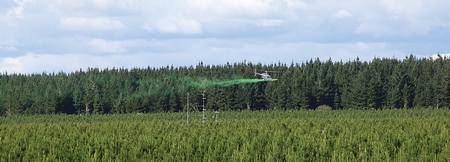Advanced technologies expand our knowledge of spray deposition

Sampling towers collect data during field trials of aerial spray drift.
The widely used AGDISP™ spray drift model uses broad assumptions to factor in this information when calculating spray drift and deposition of pesticides aerially released for forest protection and pest eradication purposes. AGDISP™, initially created by the US Forest Service, is undergoing further development at Scion in collaboration with the US Forest Service and others.
Dr Tara Strand, Scion Research Leader for Pest Management, explains that the AGDISP™ model is possibly overestimating drift in some circumstances due to an underestimation of spray deposition at canopy top. The canopy top is likely to be ‘grabbing’ more aerosol droplets than calculated within the model. Until recently, this hypothesis could not easily be tested because deployable field-ready technology was not available.
Thanks to the use of the advanced backscatter LiDAR technology and sensitive instruments that measure temperature, wind velocity and turbulence an international team of scientists has been able to collect data that will be used to evaluate the accuracy of these calculations and scientifically advance our understanding of canopy-top induced turbulence.
The team comprises Scion’s Pest Management Team and scientists from the US Forest Service, University of South Carolina and Lincoln Agritech Ltd. They converged on Scion in April to conduct a series of field trials to test their hypothesis and are now analysing the large amounts of data (a terabyte) acquired during the trial.
The analyses will lead to changes within the AGDISP™ model that will improve its calculation of drift and deposition. Results will also lead to further understanding of turbulence at the canopy top, which also has applications in seed dispersal, such as the spread of wildings, unpredictable fire behaviour, and the spread of fungal spores and other pathogens.
“Aerosol deposition is influenced by meteorology, turbulence and the roughness of the surface as well as the physical properties of the aerosols themselves, and where, when and how they are applied,” says Tara.
“Understanding how aerosol spray moves in the air is critical for risk assessment and ensuring the right amount of chemical is applied. It also helps us further our knowledge of aerosol behaviour in complex environments such as forests, urban areas and ports.
“These advanced technologies have enabled us to capture the vertical profile of an aerial spray drift cloud and study, in more detail, the effects of canopy turbulence.”
The team used Dr April Hiscox’s (University of South Carolina) LiDAR instrument to measure the aerosol droplet cloud as it drifted over a 10-m tall sampling tower, and obtained data on cloud height and size. This is a novel method for estimating deposition at the canopy top and will be evaluated as a possible replacement for standard, labour intense, deposition study methods.
The sampling tower was deployed with eight smaller towers with sampling devices, sourced from the US Forest Service and Scion, to capture spray droplet deposition at different heights. Another 10-m tower was equipped with five wind sensors and eight temperature sensors to measure changes by the second or less.
“The need for drift reduction constrains chemical control applications. Improving deposition and drift estimates will reduce treatment costs while maintaining high environmental standards,” explains Tara.
“Based on our results, we aim to develop a new algorithm for the AGDISP™ model. Impacts for industry will be significant, especially for eradication programmes in urban areas where any off-target drift can have very serious implications. Further understanding of deposition and drift improves industry’s capabilities to aerially apply pesticides on-target in both pest management and eradication applications.”
This project will produce three peer-reviewed papers for the scientific audience. Results will be disseminated to industry directly through presentations and a technical note and indirectly through the insertion of the algorithm in AGDISP™. Immediate uptake is expected as this model is used during eradication programmes to quantify efficacy of the application and off-target drift.
For further information
Contact Dr Tara Strand at Show email
